Infraspection Institute
425 Ellis Street
Burlington, NJ 08016
Tel. 609-239-4788
www.infraspection.com
Introduction
Infrared inspections are now a matter of routine for many commercial and industrial facilities. By proactively addressing incipient or latent failures detected during a single inspection, facility managers are able to avoid costs associated with unscheduled downtime and damage to electrical and mechanical equipment. Even greater savings can be achieved through a properly designed and managed infrared inspection program.
It is important to note that we are speaking about a program rather than an individual inspection. A program is an engineered predictive maintenance approach that will provide a system for instituting, adapting, and continually improving infrared inspection activities to provide long-term value and maximum payback to the facility.
In general, the steps that we will cover are applicable to any predictive maintenance program. The principles that we discuss will work for setting up or improving an existing program. This program may be instituted by an in-house inspection team or professional consulting firms providing contract services for their client’s facilities.
Step 1 – Determine What to Inspect
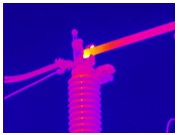 The first step in setting up an infrared inspection program is deciding what systems or units to inspect. To do this, one must determine what systems are best suited for infrared inspection within the facility. Typically, systems where failures are accompanied by a change in operating temperature prior to failure are excellent candidates for infrared inspection. Typical industrial systems include: electrical systems, mechanical systems, rotating equipment, process equipment, boilers and steam systems, insulated structures, and flat roofs.
The first step in setting up an infrared inspection program is deciding what systems or units to inspect. To do this, one must determine what systems are best suited for infrared inspection within the facility. Typically, systems where failures are accompanied by a change in operating temperature prior to failure are excellent candidates for infrared inspection. Typical industrial systems include: electrical systems, mechanical systems, rotating equipment, process equipment, boilers and steam systems, insulated structures, and flat roofs.
When deciding which systems to include, consideration should be given to the consequences of equipment failure. Systems or components that should be prioritized include the following: items that can create bottleneck situations, items where failure can lead to widespread damage, and items that can cause a significant interruption of production.
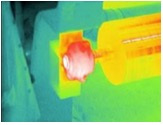 Another key to setting up an infrared inspection program is considering equipment which is critical to facility operations. Equipment which is vital should be given priority. Particular attention should be given to systems or components that can affect production, life support, Uninterruptible Power Supply systems and generators, and safety. Equipment failure history should also be considered. Equipment which has a history of frequent failures that are accompanied by a change in operating temperature should be included, as well.
Another key to setting up an infrared inspection program is considering equipment which is critical to facility operations. Equipment which is vital should be given priority. Particular attention should be given to systems or components that can affect production, life support, Uninterruptible Power Supply systems and generators, and safety. Equipment failure history should also be considered. Equipment which has a history of frequent failures that are accompanied by a change in operating temperature should be included, as well.
When starting an infrared inspection program, it is recommended that one start small and then expand. Because of the wide range of applications for thermography, there may be great temptation to include a large number of systems initially. This can be problematic especially when manpower is in short supply. A shortage of manpower is likely to occur especially when instituting a new program for which no additional personnel have been allotted.
Step 2 – Make an Inventory List
Once you have decided what equipment to inspect, it is time to categorize the subject equipment. To do this, you will need to generate inventory lists or inspection routes. Ideally, your inspection routes will be lists of equipment to be covered during your infrared inspections which will serve as blueprints for your infrared inspection activities. It is recommended that routes not contain more equipment that can be inspected in a single workday. It should be noted that industry standards require that an inventory list be included for all equipment inspected during an infrared inspection of electrical and mechanical systems. If infrared inspections have already been performed, look to inventory lists that may already exist.
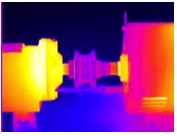 Ideally, routes should be of the same class or hierarchy. Whenever possible, use the same routes as those that have already been generated for other predictive maintenance technologies (PdM) such as vibration analysis, ultrasonic inspections, or lubrication testing. When generating routes, one should also give consideration to travel time and set up at each inspection location. In some facilities, it may be more effective to group equipment or systems by area or building rather than by equipment type.
Ideally, routes should be of the same class or hierarchy. Whenever possible, use the same routes as those that have already been generated for other predictive maintenance technologies (PdM) such as vibration analysis, ultrasonic inspections, or lubrication testing. When generating routes, one should also give consideration to travel time and set up at each inspection location. In some facilities, it may be more effective to group equipment or systems by area or building rather than by equipment type.
Step 3 – Assign Inspection Frequencies
Once routes have been generated, one must assign inspection frequencies. For some systems, annual inspections may be sufficient. For other systems, semiannual inspections such as quarterly or monthly may be warranted. To effectively determine the frequency of infrared inspections for subject systems, be sure to keep the following in mind.
Whenever possible, review data for systems which have previously failed. Equipment that exhibits a change in operating temperature prior to failure should be included. Typically, inspections should be performed at a frequency equal to the experienced or expected half-life of prior failures. For example, a particular type of rolling element bearing is failing once every six months. Initial inspection frequency should be set to once every three months. For condition monitoring, a minimum of ten measurements are needed for an accurate statistical trend.
When setting inspection frequencies, one should consider stresses on the subject equipment. Equipment which is subject to extreme hot or cold temperatures, constantly changing load, running at or near capacity, or is exposed to physical stress should be inspected more frequently.
Adjust frequencies as necessary. A key component of an infrared inspection program is that inspection frequencies are adjusted periodically. As the infrared inspection program begins to provide meaningful data, it is expected that the number of exceptions per inspection found will decrease over time. As this occurs and system reliability improves, adjusting inspection frequencies will help to free up manpower to perform inspections elsewhere.
Step 4 – Set Temperature Limits
Our next step in setting up an infrared inspection program is to set temperature limits. For qualitative inspections, temperature limits need not be hard values. Rather, our temperature limit for a qualitative 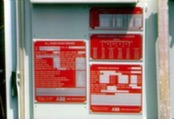 inspection is that any inexplicable temperature rise is reported as an exception. Once you have completed the Infraspection Institute Level II infrared thermography course, you may wish to use quantitative data in setting temperature limits.
inspection is that any inexplicable temperature rise is reported as an exception. Once you have completed the Infraspection Institute Level II infrared thermography course, you may wish to use quantitative data in setting temperature limits.
When setting temperature limits, it is possible to use manufacturers’ limits. Such temperature limits may be obtained from the equipment nameplate data such as those found on transformers and motors. For bearings and rotating equipment, temperature limits may be established using lubrication data.
Another viable way of setting temperature limits is to use site experience. Whenever possible, review operational data regarding previous failures. Typically, maintenance personnel and machine operators are aware of the temperature limits of equipment based on their previous experience. Whenever possible, utilize this valuable info to help set operational temperature limits.
Always remember that heat shortens equipment life. This is true for any electrical and mechanical equipment. For wound electrical equipment such as transformers and motors, a time-tested rule of thumb states that, “For every 10 centigrade degrees that a device exceeds its rated maximum temperature, its insulation life will be reduced by 50%.”
Step 5 – Perform Inspections
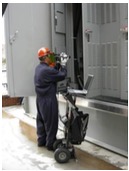
Once we have planned our inspections, we need to actually perform them. To accomplish this, give consideration to the following.
Select your people. Typically, persons with an electrical, mechanical or construction background are particularly suited for thermography. Persons trained in other PdM technologies may be particularly suited as well. Other useful skills should include: the ability to effectively communicate, good investigative skills, and physical capabilities suited to the inspection challenges including the ability to see color.
Once you have selected your people, be certain to obtain unbiased training and certification. Infrared training courses are generally listed by levels which range from one to three. Such levels generally correspond to levels of qualification for test personnel as defined by the American Society of Nondestructive Testing (ASNT) and the International Organization for Standardization (ISO). In selecting formal training for thermographers, be certain to choose a reputable training firm that does not have a bias toward a particular brand of thermal imaging equipment.
Be certain to get repeatable data. Following the standards such as those published by Infraspection Institute will help to ensure that thermographers gather all pertinent data necessary to document conditions properly. For trending, it is imperative that such data are collected during each inspection to help ensure repeatability during future inspections.
All infrared inspections should be documented in accordance with the published standards. Properly documented findings include thermograms and control photographs for each exception identified along with all pertinent data surrounding each thermal anomaly. Using a quality software program to manage data and generate infrared inspection reports will help to ensure that all requisite data are collected and properly stored for future reference.
Step 6 – Generate a Work Order
Whenever possible, tie your infrared findings into your Computerized Maintenance Management Software system. Entering data from your infrared inspection into your computerized maintenance management system allows access to data for future reference and reporting. When appropriate, generate a work order detailing inspection findings and the anticipated repairs or actions required.
Once a work order has been generated, be certain that it is routed to the appropriate repair team or department responsible for the subject component. Make certain that technicians with the appropriate skills are assigned to the repair. Furthermore, it is imperative that repair technicians understand the information contained in the infrared inspection report and what they should be looking for when they investigate each thermal anomaly.
Whenever possible, obtain any damaged components. Such components can provide valuable insight as to failure mechanisms or equipment weaknesses. Studying damaged components allows thermographers to add to their experience base and to better anticipate how similar failures may appear in the future.
Step 7 – Re-Inspect All Repairs
An important part of an inspection program is to re-inspect all repairs. Re-inspecting after repair efforts have been expended is the only way to ensure problems have been solved. It is alarming to perform a follow-up inspection and discover that nearly all problems originally reported still exist even after repair efforts have been reportedly expended. It should be noted that an infrared inspection program is only as effective as the completed repairs. Whenever possible, note the type or cause of the problem that was found.
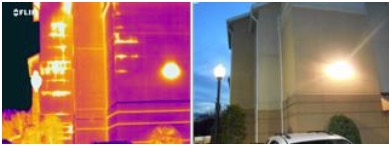
Upon completion of repairs, one should note what materials were used for repair. This information can be extremely valuable when obtaining parts or planning for similar future repairs. Additionally, note how much time it took to complete repairs. Whenever possible, be specific and note the number of man-hours. Again, this is useful for planning similar repairs in the future. Make certain to thermographically re-inspect each repaired component within 24 to 48 hours of repair or retrofit. This is particularly important to ensure that the repairs have been effective and that new problems have not developed.
Step 8 – Document Savings and/or Avoided Costs
At the completion of the infrared inspection, it is imperative to document savings or avoided costs. Eventually, this information will be essential for the continuation of an infrared inspection program.
During lean periods, managers may ask of your program, “What have you done for me lately?” The inability to answer this question with hard facts may be the undoing of your infrared inspection program since in-house programs must be continually sold. Don’t assume that management will know the value of your infrared inspection program unless you communicate with them. Fortunately, thermography is a very graphic tool that most people can quickly comprehend.
When generating a cost savings report, always use conservative figures. Sticking to the most proximate and conservative figures will leave less room for argument and may lend more credibility to your estimate. This is important because avoided costs can add up so quickly that others may be suspicious of large dollar figures. Oftentimes the larger the potential savings, the more prone others are to disbelieve your figures.
Step 9 – Root Cause Failure Analysis
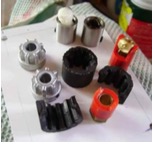 At the completion of effective repairs and re-inspection, it is recommended that Root Cause Failure Analysis (RCFA) be performed. For each exception found, the root cause of the problem should be investigated to determine if the problem was caused by design, workmanship, or material failure. This type of information can be invaluable for improving a company’s engineering designs, installations, material procurement, and/or maintenance practices. It can have even greater impact upon a company’s bottom line especially when it results in a permanent improvement to a process or system.
At the completion of effective repairs and re-inspection, it is recommended that Root Cause Failure Analysis (RCFA) be performed. For each exception found, the root cause of the problem should be investigated to determine if the problem was caused by design, workmanship, or material failure. This type of information can be invaluable for improving a company’s engineering designs, installations, material procurement, and/or maintenance practices. It can have even greater impact upon a company’s bottom line especially when it results in a permanent improvement to a process or system.
About the Author
Jim Seffrin has been an Infraspection Institute Certified Infrared Thermographer® since 1984. Jim is a co- founder of Jersey Infrared Consultants and a practicing thermographer with over 35 years experience as an infrared consultant. A Level III Infraspection Institute Certified Infrared Thermographer® and Certified Maintenance Reliability Professional (CMRP), Jim has written numerous articles, co-written existing standards, and frequently works as an expert witness on projects involving thermography. Jim has been teaching for Infraspection since 1995 and was appointed Director of Infraspection Institute in April 2000. Jim is also an Infraspection Institute Master Thermographer®.


